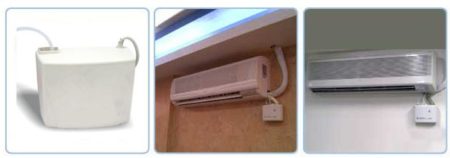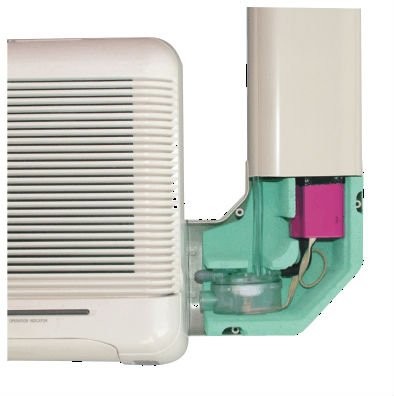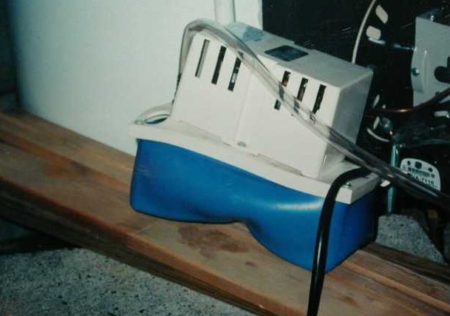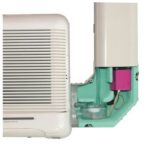During operation, the air conditioner produces a large amount of condensation liquid, which must be removed from the system and, accordingly, from the room. It is for this purpose that a device called a drainage pump or in other words a pump for an air conditioner, which consists of the following structural elements, was created:
- a pallet compartment; condensate produced will accumulate in it;
- a special drainage route along which condensation will be transported;
- drainage pump for air conditioning.
This article will discuss a separate element of the system, namely, we will explain what is needed drainage pump for air conditioner, its structure and design.
Why do I need a pump for an air conditioner

Absolutely all pumps are equipped with oversized pumps so that they can cope with the condensate of the air conditioner that it produces during operation. Their productivity is designated as - liters per hour. Also, when choosing a device, adhere to the following parameters:
- water column height;
- noise effect during operation;
- and other specifications.
See also:
- 5 best Toshiba air conditioners of the year
- 5 best Panasonic air conditioners of the year
- 5 best LG air conditioners of the year
- 5 best Daikin air conditioners of the year
- 6 best air conditioners Mitsubishi Electric of the year
Device purpose

Often, these pumps are used for breakdowns of air conditioners or their installation in specific conditions where an additional pump is required for pumping out condensate.
As a rule, manufacturers pre-assemble their drainage pumps, already the initial pump for the air conditioner, Thus, all the technical values and parameters of these devices already meet all the necessary conditions in order to ensure full operation of the air conditioner.
The drainage system itself must be installed next to the air conditioner in those cases where a very long route along which condensation flows out. After all, it happens when, due to the long path of the liquid, it is necessary to overcome height differences, because of which there is a loss of pressure, and it simply does not leak. The selection of the pump for drainage is based on the environmental conditions in which it will be used. Below we will talk about the types of drainage pumps.
![]() See also - How to choose and install the bracket for the air conditioner
See also - How to choose and install the bracket for the air conditioner
Types and features of the drainage system

All drainage pumps can be divided into several types, and each of them is designed to work in certain conditions:
- Split type pumps - they are equipped with a small tank, which is equipped with a sensor to determine the level of liquid inside. Thanks to their special structure, they can be mounted on drain pipes, on the drainage path itself, or inside the condensate compartments. However, the standard mounting location is a separate special unit that connects to pallets or a flexible system tube that is two meters long. The performance indicator for these pumps ranges from 7 to 60 liters of fluid per hour. This value is sufficient for most modern models of air conditioners. Subject to the conditions of proper installation, they are able to pump condensate to a height of up to 15 meters. However, they are not suitable for installation in specific operating conditions.
- Pumps of bulk options - equipped with capacious tanks, and they do not have a sensor that detects the water level. They have more power compared to the previous type, since their performance value starts at 80 liters per hour, and can reach up to 1500 liters. However, there is one drawback, they are not able to lift the liquid to a great height, their maximum is about 7 meters. These systems are not intended for lifting liquids, since they were created to service external block multisplit systems, and the condensate passing through them flows directly into the sewer system.
- Built-in pumps - they are mounted in all standard cassette and channel split systems, as well as in air conditioners from famous manufacturers in this area. As for the performance value, it starts at 5 liters per hour, and the maximum reaches 165 liters. Designed for mounting in specific conditions, except when the system needs an additional vacuum source for pumping out condensate.
- Peristaltic pumps - created to raise water to a height of 15 meters. The performance of these systems is very small, it is 10 liters per hour. The downside is that they are overpriced compared to their counterparts. And systems with high power will also cost more than other analogues.
![]() See also - Which manufacturer of air conditioners is the best in price and quality
See also - Which manufacturer of air conditioners is the best in price and quality
System installation specifics
There are several ways to install the drain pump. However, it is not always needed, if you install the drainage tube correctly and at the same time maintain an inclined angle, the condensate will flow on its own, then in this case the system will not be needed. But to do this does not always work, therefore, a drainage pump for the air conditioner was made. With its help, it is possible to achieve all the necessary conditions in order to ensure free condensate, even if it is removed in a timely manner from the system.
![]() See also - DIY air conditioning installation
See also - DIY air conditioning installation
Cons of drainage pumps
They mainly concern the design:
- due to the fact that the systems are equipped with a small electric drive, which brings the system into working condition, it can be somewhat noisy, which causes some discomfort to some owners;
- free access is necessary for the drainage pump, since it will be necessary to constantly clean the filters, which are quickly clogged up due to the fact that the condensate is produced and the leak takes dust with it, which is bad for the system, which can lead to poor performance or even breakdown.
See also:
- 7 best Hisense air conditioners according to customer reviews
- The 9 best Electrolux air conditioners of the year
- 10 best Ballu air conditioners of the year
- 10 best General Climate air conditioners according to customer reviews
- 20 best home air conditioners


